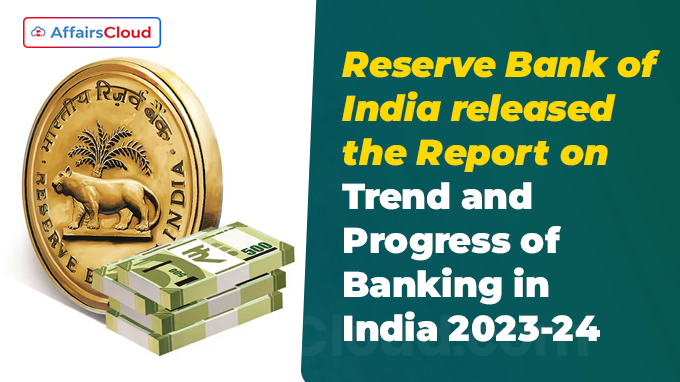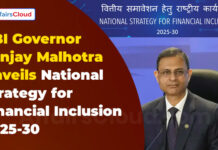 The Reserve Bank of India (RBI) has released the Report on Trend and Progress of Banking in India 2023-24 under Section 36(2) of the Banking Regulation Act, 1949.
The Reserve Bank of India (RBI) has released the Report on Trend and Progress of Banking in India 2023-24 under Section 36(2) of the Banking Regulation Act, 1949.
- It presents the performance of the banking sector, including commercial banks, co-operative banks and non-banking financial institutions, during 2023-24 and 2024-25 so far.
Banks’ profitability improves for 6th year in row in FY24
i.According to RBI’s report, profitability of the commercial banks in India increased for the 6th consecutive year in 2023-2024.
ii.The banks witnessed a Return on Assets (RoA) of 1.4% and a Return on Equity (RoE) of 14.6% in Financial Year (FY) 2024 with profitability remaining robust in the first half of FY25.
iii.In order to close the credit-deposit gap, the banks had to raise their deposit rates and borrow money at higher interest rates.
- Thus, the interest expense-to-income ratio, increased to 57.4% in FY24, compared to 52.2% in FY23 leading to a slowed growth rate in operating and net profits.
- At the end of March 2023, there was a total on year rise in net profit of 44.6%, while operating profit had climbed 18.2%.
iv.Net profit of the scheduled commercial banks increased by 32.8 per cent to Rs 3,49,603 crore during the last fiscal.
- At end-March 2024, India’s commercial banking sector consisted of 12 public sector banks (PSBs), 21 private sector banks (PVBs), 45 foreign banks (FBs), 12 SFBs, six PBs, 43 RRBs, and two LABs. Out of these 141 commercial banks, 137 were classified as scheduled banks, while four were non-scheduled.
Banks’ GNPA Hit 13-Year Low
i.The report showed that the banks’ gross non-performing assets ratio (NPA), or the proportion of bad assets to total loans, declined to a 13-year low of 2.5% at end of September from 2.7% at end-March 2024.
- In terms of asset quality, gross non-performing assets (GNPA) declined by 15.9% year on year to Rs 4.8 lakh crore as of March 31, 2024.
ii.Net NPA fell to 0.57% of total loans in September 2024, from 0.62% at end-March 2024.
iii.While the agricultural sector reported the highest GNPA ratio at 6.2%, retail loans had the lowest ratio at 1.2%.
Banking frauds in India rose to 18461 cases in H1FY25
i.According to the RBI data, the number of bank frauds witnessed a significant increase of 27 per cent year-on-year in April-September 2024 to 18,461 cases and the amount involved jumped more than eight-fold to Rs 21,367 crore as compared to 14,480 cases involving Rs 2,623 crore in FY23.
ii.The share of internet and card frauds in the total stood at 44.7% in terms of amount and 85.3% in terms of number of cases in accordance to the occurrence of frauds in 2023-24.
- In 2023-24, the number of fraud cases reported by PVBs accounted for 67.1% of the total.
- The total penalty amount more than doubled in 2023-24 to Rs 86.1 crore, led by public and private sector banks.
CRAR of SCBs was 16.8% at end-September 2024
The report showed that the capital to risk-weighted assets ratio (CRAR) of Scheduled Commercial Banks (SCBs) was 16.8% in September 2024, with all bank groups meeting the regulatory minimum requirement and the common equity tier 1 (CET1) ratio requirement.
- The consolidated balance sheet of SCBs, excluding regional rural banks, increased by 15.5% during 2023-24 wherein share of PSBs fell to 55.2% while that of PVBs increased to 37.5%.
- The bank’s liquidity coverage ratio (LCR) fell from 135.7 per cent in September 2023 to 128.5 per cent in September 2024
About CRAR Ratio:
i.Capital Adequacy Ratio (CAR) also known as Capital to Risk (Weighted) Assets Ratio (CRAR), is the ratio of a bank’s capital in relation to its risk weighted assets and current liabilities. It is an indicator of a bank’s ability to pay liabilities, and respond to credit risks and operational risks.
ii.The minimum CAR requirement for banks in India is set at 9%, and 11.5% including the capital conservation buffer, and the Tier 1 capital requirement is pegged at 7%, both one percentage point above the Basel III requirements.
Over 600k loans worth Rs 27,000 cr disbursed on ULI platform
i.According to the report. Unified Lending Interface (ULI), Reserve Bank of India’s (RBI) Unified Payment Interface (UPI)-like digital public infrastructure in lending space, has provided over 600,000 loans worth Rs 27,000 crore.
- Out of this, about 160,000 loans amounting Rs 14,500 crore are to micro, small, and medium enterprises (MSMEs).
ii.Moreover,12 loan segments have been introduced on the ULI platform, including kisan credit card, digital cattle, MSME (unsecured), housing, personal, tractor, micro business, vehicle, digital gold, e-Mudra, pension and dairy maintenance loans.
Private banks outrun public sector peers in priority lending benchmarks
i.The RBI data reported that PVBs have met priority sector lending (PSL) targets, including sub-targets for major heads in 2023-24, particularly in agriculture and have done better than PSBs.
ii.The total trading volume of priority sector lending certificates (PSLCs) increased to 26% in FY24, primarily led by PSLC-General. Among the four PSLC categories, the small and marginal farmers category registered the highest trading volume.
- In the past five years, PVBs have emerged as major sellers of PSLCs accounting for 49% of total sales in FY24 as compared with 21% in the case of PSBs.
Note:
i.For the public sector, private and foreign banks, the target is 40% of adjusted net bank credit (ANBC) or credit equivalent of off-balance sheet exposure, whichever is higher.
ii.For small finance banks, the target is higher at 75%.
About Priority sector lending certificates (PSLCs):
i.Priority Sector Lending Certificates (PSLCs) are tradable certificates issued against priority sector loans of banks so as that the banks can achieve their specified target and sub-targets for priority sector lending through purchase of these instruments at the time of shortfall and utilizing the surplus to lend more to these sectors.
ii.There are four kinds of PSLCs-
- PSLC Agriculture
- PSLC Small and Marginal Farmers (SF/MF)
- PSLC Micro Enterprises
- PSLC General
Below is the table showing allocation of funds to the borrower segments:
| Borrower Segment | Target | Public Sector | Private Sector | Foreign | Small Finance |
|---|---|---|---|---|---|
| Total Of which: | 40/75* | 42.6 | 47.4 | 41.6 | 90.6 |
| Total Agriculture | 18.0 | 19.1 | 18.7 | 18.6 | 26.8 |
| Small and Marginal Farmers | 10.0 | 11.2 | 10.0 | 11.0 | 18.2 |
| Non-Corporate Individual Farmers | 13.8 | 14.2 | 14.0 | 14.2 | 25.4 |
| Micro-Enterprises | 7.5 | 8.0 | 10.2 | 8.5 | 32.6 |
| Weaker Sections | 12.0 | 14.1 | 12.1 | 12.1 | 35.8 |
* Total priority sector lending target for small finance banks is 75%.
NBFC Lending Surges 18.5%, Improved Asset Quality In FY24
i.The RBI report showed that loans and advances of non-banking financial institution (NBFC) increased by 18.5% in FY24, crossing the previous year’s growth of 17.4%.
ii.NBFCs have sourced funding from bank (42.7%) in March 2024. non-convertible debentures (NCDs), Commercial paper borrowings and external commercial borrowings (ECBs) which represented 57.5% of foreign funding.
About Reserve Bank of India (RBI)
The Reserve Bank of India (RBI) is responsible for monetary stability, currency management, targeting inflation, regulating the banking system, and setting interest rates. It was established on April 1, 1935 in accordance with the provisions of the Reserve Bank of India Act, 1934.
Headquarters: Mumbai, Maharashtra
Governor: Sanjay Malhotra




